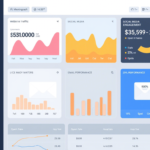The Power of Marketing Campaigns: A Blueprint for Business Growth
In today’s fast-paced business world, marketing campaigns are not just tools—they’re catalysts for transformation. They’re the spark that ignites new opportunities, builds trust, and drives measurable results. Whether you’re a small business owner or a nonprofit leader, campaigns offer a structured way to focus your efforts, allocate resources wisely, and achieve specific goals without starting from scratch.
Think of a marketing campaign as a tree. Its roots draw nourishment from the fertile soil of your existing brand foundation—your mission, values, and customer relationships. The trunk represents your core brand identity, while the branches symbolize the outcomes: engagement, trust, growth, and revenue. When nurtured with data-driven strategies and creative execution, this “campaign tree” can grow into something extraordinary.
But here’s the catch: running a successful campaign isn’t always easy. Many businesses abandon their efforts too soon because they feel overwhelmed by technical platforms like Meta Ads or Google Ads. Others dive in without proper planning, wasting budgets on ineffective ads. The truth? With the right approach, campaigns don’t have to be daunting. They can be one of the most rewarding investments you make.
Let’s break down how to plan, execute, and measure a winning marketing campaign—and why it’s essential for your business’s growth.
Why Start with a Campaign Instead of a Full Rebrand?
When I work with clients who need a marketing overhaul, it’s tempting to recommend a complete rebranding strategy. While there’s certainly a time and place for that, starting with a focused campaign is often smarter. Why?
- Proof of Concept : A well-defined campaign demonstrates what effective marketing looks like in action. It gives you tangible results—like increased sales, donations, or website traffic—that build confidence in your overall strategy.
- Cost Efficiency : Campaigns allow you to test ideas on a smaller scale before committing to larger initiatives. For example, a boutique bakery might run a 90-day campaign to promote a new line of artisanal desserts, using insights gained to refine future offerings.
- Real-Time Adjustments : Unlike long-term marketing plans, campaigns provide flexibility. You can track performance metrics daily, tweak targeting, and optimize ad spend to maximize ROI.
In short, campaigns are the perfect stepping stone to bigger things. They let you experiment, learn, and grow—all within a manageable timeframe and budget.
What Makes a Great Marketing Campaign?
A great campaign zeroes in on clear objectives and delivers measurable results. Here’s what sets it apart:
1. Clear Goals
Every campaign should aim for something specific. For instance:
- A product company might want to boost holiday sales.
- A nonprofit could target raising $10,000 during Giving Tuesday.
- A service provider may focus on attracting new clients through lead generation.
Using SMART goals (Specific, Measurable, Achievable, Relevant, Time-bound) ensures everyone stays aligned. For example: “Increase website traffic by 25% over three months.”
2. Targeted Audience
Knowing your audience is non-negotiable. Broad targeting wastes money; instead, identify who your ideal customers are, map their journey, and tailor your messaging accordingly.
3. High-Quality Creatives
Your visuals and copy must reflect your brand’s personality. Consistent colors, fonts, and logos build recognition and trust. Avoid relying solely on AI-generated content—it lacks the emotional depth that connects with audiences.
4. Data-Driven Execution
Data is the backbone of any successful campaign, from setting up analytics tools like Google Analytics to tracking key performance indicators (KPIs). Metrics like click-through rate (CTR), cost per click (CPC), conversion rate, and return on ad spend (ROAS) tell you exactly what’s working—and what’s not.

The Math Behind Marketing Campaigns
Yes, we’re diving into numbers—but don’t worry, this won’t feel like a math textbook. Understanding the financial side of campaigns is crucial for making informed decisions.
Budget Breakdown
Most campaign budgets fall into three categories:
- Development Costs (e.g., graphic design, video production): Essential for standing out.
- Advertising Spend (e.g., Google Ads, Meta Ads): Often the largest expense.
- Management Fees (e.g., agency fees, software subscriptions): Covers setup, optimization, and reporting.
A 1:1 ratio between ad spend and management costs works well for small campaigns. As your budget grows, management costs typically decrease as a percentage of the total.
Key Metrics to Track
Here’s a quick rundown of critical KPIs:
- CTR : Aim for 2–3%. If it’s lower, tweak your ad copy or visuals.
- Conversion Rate : Industry averages range from 2–5%, but highly targeted campaigns can exceed 10%.
- CPC : Keep it in line with your industry benchmarks. For example, under $1 is considered low for Google Ads.
- ROAS : A 3x return is a solid baseline. Anything below 2x signals room for improvement.
Forecasting Success: Predictive Analytics for Campaigns
While past performance provides valuable insights, forecasting takes it a step further. By leveraging predictive analytics, you can anticipate trends, seasonality, and even external factors like competitor actions.
Some common forecasting techniques include:
- Time Series Analysis : Identifies patterns in historical data (great for recurring events like holiday promotions).
- Seasonal Decomposition Models : Tools like Meta’s Prophet handle real-world irregularities effectively.
- Simulation Models : Test “what-if” scenarios to determine optimal budget allocations.
Remember, forecasting is both an art and a science. Combine quantitative analysis with qualitative insights, such as customer feedback, to create realistic expectations.
Tips and Pitfalls for Campaign Success
Even the best analytics won’t save a poorly executed campaign. Here’s how to avoid common pitfalls:
Tips for Success
- Define Your Audience Clearly : Avoid broad targeting—it dilutes your message.
- Invest in Quality Creatives : Professional visuals pay off.
- Set Realistic Expectations : Pilot campaigns help refine strategies without overspending.
- Optimize Continuously : Monitor metrics in real-time and adjust as needed.
Pitfalls to Avoid
- Overspending on One Channel : Diversify your ad spend to reduce risk.
- Neglecting Mobile Optimization : Most users browse on phones, so ensure your ads and landing pages look great on mobile devices.
- Confusing Marketing with Sales : Campaigns build awareness and generate leads—not close deals. Align expectations accordingly.

A Real-World Example: A Boutique Bakery’s 90-Day Campaign
Imagine a local bakery launching a new line of artisanal desserts. Their goal? Drive 1,500 leads and boost in-store sales over 90 days with a $7,500 budget.
Budget Allocation
- Development : $1,500 for high-quality photos, videos, and social media templates.
- Advertising : $4,500 split between Google Ads ($900/month) and Meta Ads ($600/month).
- Management : $1,500 for campaign setup, ongoing optimization, and analytics tracking.
Activities
- PPC Advertising : Target keywords like “artisan bakery near me.”
- Social Media : Boost posts and run contests to engage users.
- Email Marketing : Announce the new product line and offer exclusive discounts.
Expected Results
- CTR : 3%
- CPC : $0.50
- Conversion Rate : 10%
- ROAS : 3x
By the end of the campaign, the bakery expects to earn $22,500 in revenue—a 3x return on investment.
Conclusion: Plant the Seeds of Growth
Marketing campaigns are more than just promotional pushes—they’re investments in your business’s future. By focusing on measurable goals, understanding key metrics, and leveraging data-driven strategies, you can create campaigns that deliver immediate results and lay the groundwork for long-term success.
So, what are you waiting for? Set clear objectives, allocate a realistic budget, and start planting those seeds today. With thoughtful planning and continuous optimization, your campaigns will grow into thriving branches of engagement, trust, and revenue.






















